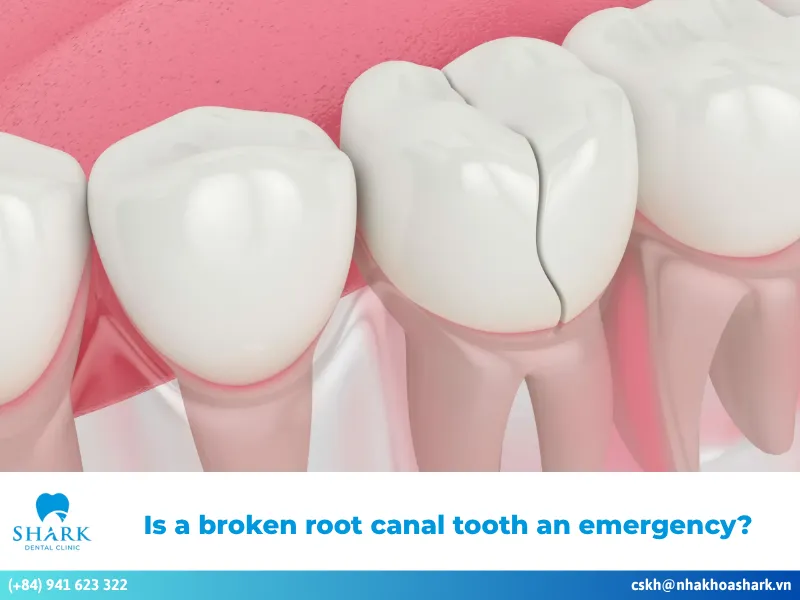Root canal treatment is a dental procedure that helps preserve natural teeth and prevent infection when the pulp is either necrotic or has reduced function. However, the number of root canals required can vary based on age. In this article, we will explore the average number of root canals by age and the factors that influence this.
What is the average number of root canals by age?
On average, individuals may need root canal treatments between 1 and 3 times, depending on several factors, including their age.
Early – the late 20s
The average number of root canals for people in their 20s ranges from 1 to 2. Scientific statistics indicate that the age group of 20–29 accounts for the highest proportion of endodontic cases. However, this group usually has strong and healthy tooth structures, making root canal procedures easier and more favorable compared to older patients.
Middle age – mid-60s
For individuals in their 60s, the average number of root canals typically ranges from 2 to 3. At this age, the tooth structure has generally weakened, becoming more brittle and prone to fractures. As a result, root canal treatments tend to require more time.

Factors affecting the age of root canal treatment
Most patients will need multiple root canal treatments, and the actual number of sessions can vary based on several factors, including:
- Oral infection level: The extent of pulpitis—whether mild, necrotic, or associated with an abscess after root canal—can influence the number of necessary sessions. Dentists will examine the overall oral health and the level of infection to create a specialized treatment plan that ensures maximum safety.
- Tooth location: Each tooth position has distinct root canal anatomy and morphology, which affects the number of treatments required. For instance, incisors typically have 1–2 canals with a simple structure, making them easily accessible and often treatable in one visit. In contrast, molars may have 3–4 canals with complex branching, necessitating 2–3 appointments for thorough treatment.
- General health of the patient: The number of root canal sessions can also depend on the patient’s overall health. If a patient has conditions such as unstable blood pressure, diabetes, or anxiety disorders, treatment may require 2–3 visits or more, depending on their specific health situation. This careful scheduling ensures the procedure is safe and directly impacts how long does a root canal take to heal effectively.
- Dentist’s expertise and technique: The skill level of the dentist plays a significant role in determining the number of visits needed. An experienced dentist can apply accurate techniques for quicker root canal treatments, thereby optimizing time. In contrast, less experienced dentists may take longer and require additional appointments.
- Dental equipment and technology: In addition to the dentist’s expertise, the quality of endodontic equipment and tools can influence treatment duration. A dental clinic that is equipped with modern and advanced systems can facilitate faster, safer, and more effective root canal procedures.
- Oral care after treatment: Patients must maintain a healthy diet and proper oral hygiene after root canal treatment. Although the canal is sealed, poor eating habits and inadequate hygiene can lead to bacterial reinfection of the tooth. In such cases, patients may need to revisit the clinic for retreatment, resulting in additional time and costs.

The number of root canal sessions can also depend on the patient’s overall health. If a patient has conditions such as unstable blood pressure, diabetes, or anxiety disorders, treatment may require 2–3 visits or more, depending on their specific health situation. This careful staging of treatment helps to mitigate any potential root canal treatment side effects.
Things you need to know before getting a root canal
In addition to the typical number of root canal treatments, many people have other concerns, such as:
Is the second root canal painful?
Typically, undergoing a second or even third root canal is not painful. Most patients may only experience slight sensitivity in the treated tooth, especially if the procedure is performed at a reputable dental clinic. With skilled professionals, extensive experience, and modern equipment, the root canal process is quick and should not harm the soft tissues in the mouth.
However, some patients may experience pain after root canal treatment for various reasons. This could be due to inadequate cleaning of the pulp during the initial treatment, errors in technique, the spread of infection, or incomplete sealing of the root canal. In such cases, a thorough examination is necessary, and retreatment may be required to reduce the risk of further infection.
>>> See more: How long does a root canal hurt?
How to reduce the number of root canals needed?
To minimize the number of root canal treatments, it’s important to choose a reputable dental clinic that employs highly skilled dentists and utilizes advanced equipment. Dentists will carefully assess your oral condition, effectively remove the infected pulp, and properly seal the root canal, which can help reduce the need for multiple treatments.

Post-treatment care after a root canal
After receiving a root canal treatment at the dental clinic, it is crucial to maintain good oral health and limit the risk of reinfection by developing a proper oral care routine and adopting healthy eating habits. Here are some recommendations:
- Prioritize soft foods and avoid excessively hot, cold, or hard foods that could damage the soft tissues in your mouth.
- Pay close attention to your oral hygiene by brushing at least 2-3 times per day. Brush gently and ensure you clean away food debris and bacteria left in your mouth.
- If you notice any signs of cracking or brittleness in the treated tooth, consider restorative methods such as dental crowns or fillings. These options can help preserve tooth function and aesthetics, keeping your smile confident and intact.
In addition to these measures, it is highly recommended to attend regular dental check-ups, ideally every 3-6 months. Follow-up visits allow the dentist to monitor your healing progress and, if residual pulp or reinfection is detected, provide timely treatment to prevent the infection from worsening.

With this information, you now have a clearer understanding of the average number of root canals by age and the factors that influence them. To keep your teeth strong and minimize the likelihood of needing multiple root canal treatments, always choose a reputable dental clinic.










